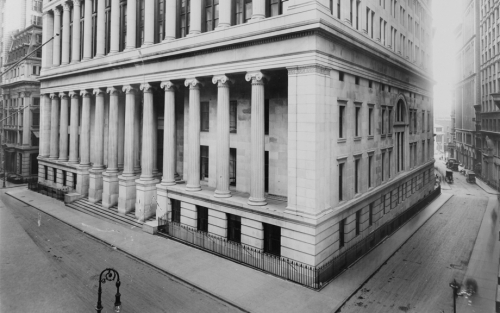How Does Supervision Affect Bank Performance during Downturns?

New research finds that there is a cyclical nature to the benefits of bank supervisory attention: in normal times, the benefits are smaller, but during downturns the more closely supervised banks exhibit better loan performance and lower earnings volatility.
Fight the Pandemic, Save the Economy: Lessons from the 1918 Flu

The COVID-19 outbreak has sparked urgent questions about the impact of pandemics, and the associated countermeasures, on the real economy. Policymakers are in uncharted territory, with little guidance on what the expected economic fallout will be and how the crisis should be managed. In this blog post, we use insights from a recent research paper to discuss two sets of questions. First, what are the real economic effects of a pandemic—and are these effects temporary or persistent? Second, how does the local public health response affect the economic severity of the pandemic? In particular, do non-pharmaceutical interventions (NPIs) such as social distancing have economic costs, or do policies that slow the spread of the pandemic also reduce its economic severity?
Did Subprime Borrowers Drive the Housing Boom?

The role of subprime mortgage lending in the U.S. housing boom of the 2000s is hotly debated in academic literature. One prevailing narrative ascribes the unprecedented home price growth during the mid-2000s to an expansion in mortgage lending to subprime borrowers. This post, based on our recent working paper, “Villains or Scapegoats? The Role of Subprime Borrowers in Driving the U.S. Housing Boom,” presents evidence that is inconsistent with conventional wisdom. In particular, we show that the housing boom and the subprime boom occurred in different places.
Once Upon a Time in the Banking Sector: Historical Insights into Banking Competition

How does competition among banks affect credit growth and real economic growth? In addition, how does it affect financial stability? In this blog post, we derive insights into this important set of questions from novel data on the U.S. banking system during the nineteenth century.
How Large Are Default Spillovers in the U.S. Financial System?

When a financial firm suffers sufficiently high losses, it might default on its counterparties, who may in turn become unable to pay their own creditors, and so on. This “domino” or “cascade” effect can quickly propagate through the financial system, creating undesirable spillovers and unnecessary defaults. In this post, we use the framework that we discussed in “Assessing Contagion Risk in a Financial Network,” the first part of this two-part series, to answer the question: How vulnerable is the U.S. financial system to default spillovers?
Assessing Contagion Risk in a Financial Network

Duarte, Jones, and Ruela describe how stress can propagate through the financial system and sketch out an approach for quantifying economic losses stemming from default cascades.
What Can We Learn from the Timing of Interbank Payments?

From 2008 to 2014 the Federal Reserve vastly increased the size of its balance sheet, mainly through its large-scale asset purchase programs (LSAPs). The resulting abundance of reserves affected the financial system in a number of ways, including by changing the intraday timing of interbank payments. In this post we show that (1) there appears to be a nonlinear relationship between the amount of reserves in the system and the timing of interbank payments, and (2) with the increase in reserves, smaller banks shifted their timing of payments more significantly than larger banks did. This result suggests that tracking the timing of payments sent by banks could provide an informative signal about the impact of the shrinking Federal Reserve balance sheet on the payments system.
Post‑Crisis Financial Regulation: Experiences from Both Sides of the Atlantic

To celebrate the 100-year anniversary of the Banca d’Italia’s New York office, the Federal Reserve Bank of New York and the Banca d’Italia hosted a workshop on post-crisis financial regulation in November 2018. The goal of the workshop was to discuss differences in regulation between the United States and Europe (and around the globe more broadly), examine gaps in current regulations, identify challenges to be addressed, and raise awareness about the unintended consequences of regulation. The workshop included presentations on such topics as market liquidity, funding, and capital requirements. In this post, we present some of the findings and discussions from the workshop.
The Indirect Costs of Lehman’s Bankruptcy

In our previous post, we assessed losses to customers and clients from foregone opportunities after Lehman Brothers filed for bankruptcy in September 2008. In this post, we examine losses to Lehman and its investors in anticipation of bankruptcy. For example, if bankruptcy is expected, Lehman’s earnings may decline as customers close their accounts or certain securities (such as derivatives) to which Lehman is a counterparty may lose value. We estimate these losses by analyzing Lehman’s earnings and stock, bond, and credit default swap (CDS) prices.
Customer and Employee Losses in Lehman’s Bankruptcy

In our second post on the Lehman bankruptcy [link to recovery blog], we discussed the cost to Lehman’s creditors from having their funds tied up in bankruptcy proceedings. In this post, we focus on losses to Lehman’s customers and employees from the destruction of firm-specific assets that could not be deployed as productively with another firm. Our conclusions are based in part on what happened after bankruptcy—whether, for example, customer accounts moved to other firms or employees found jobs elsewhere. While these indirect costs are difficult to pin down, the analysis suggests that the most notable losses were borne by mutual funds that relied on Lehman’s specialized brokerage advice and firms that used Lehman for its equity underwriting services.














 RSS Feed
RSS Feed Follow Liberty Street Economics
Follow Liberty Street Economics